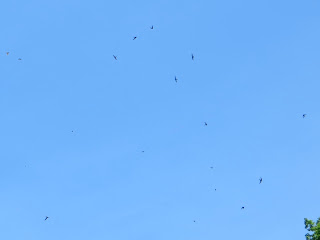 |
| Koajisashi over the Tamagawa |
Northwest of the train station an endless vista of green opens up. You can walk virtually forever along the Tama River past an infinite number of ball fields, fishing areas, playgrounds, and nature preserves. You can also walk back under the tracks if the water levels are low and tread the rocky riverbed to the southeast.
I went to the southeast first because that's where I spotted my target bird, the bird I had seen from the train platform--the
kosagi (little egret). There were a lot of them, actually. Here's one right under the platform.
 |
| Kosagi under the Futakotamagawa eki tracks. |
It was having great success with little fish trapped a pool, until I came along to scare it off... I walked further down the rocky riverbed
Also seen:
The ubiquitous
karugamo (spot-billed duck).
And a bird that more easily heard than seen--its constant peeoh-peeoh-peeoh-peeohing like a electric alarm clock with no snooze alarm--the
kochidori (little ringed plover).
Check out that awesome eye ring. I wish our plovers had them.
I headed back to the northwest. Here was well trod parkland with joggers and dog walkers and later, large lawn mowers. A grassland environment.
Filled with singing
hibari (skylarks).
I only knew
hibari from birdsong recordings. I had no idea, really no idea, what it felt like to encounter them in real life.
Here's a taste:
Utter relentless brilliance, particularly as they did the signature skylark move and sang while fluttering about high in the air.
And what's that in the clover?
A pretty little
kawarahiwa (oriental greenfinch) given away by its signature yellow wing spot.
Then back along the riverside I came across something familiar yet different.
Definitely a wagtail, but too dull to be a
hakusekirei or
kisekirei. It flew to be near a brighter bird on the river bed.
Aha! I had hit the trifecta of common wagtails. That was a
segurosekirei (Japanese wagtail) couple.
And then the battery on the camera died. So I missed shots of the
ooyoshikiri (oriental reed warbler)
(though here is a little taste of ooyoshikiri vocalization--with kochidori peeping in the background)
and female
mozu (bull-headed shrike) I encountered on the rest of the walk.
I watched a string of koajisashi (little terns) as they plunged for food then it was time to move on. Non-birding birding trip to Japan complete.



















































